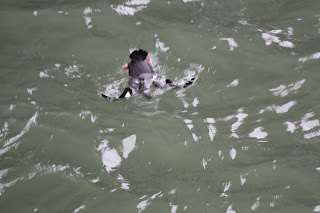Santa Cruz
_______________________________________________________________________
I was on the pier well before 7am, accompanied by a fair bit of fog, though luckily visibility was pretty much unhindered.
 My first sighting were some dark birds in the waters further up the pier. Scoters I thought, but I could make out white wing patches; quite large ones. Black Guillemot was the first thought to cross my mind, but of course here it wouldn't be Black; it would be Pigeon. And that they were. Pigeon Guillemots are winter visitors, so I imagine I was quite lucky to catch them all in total breeding plumage (in winter they are dusky and grey). They were very delightful little birds. I was surprised to learn that the musical whistling filtering the air nearby was actually coming from these birds. Sea birds are not typically so well versed in lyrics.
My first sighting were some dark birds in the waters further up the pier. Scoters I thought, but I could make out white wing patches; quite large ones. Black Guillemot was the first thought to cross my mind, but of course here it wouldn't be Black; it would be Pigeon. And that they were. Pigeon Guillemots are winter visitors, so I imagine I was quite lucky to catch them all in total breeding plumage (in winter they are dusky and grey). They were very delightful little birds. I was surprised to learn that the musical whistling filtering the air nearby was actually coming from these birds. Sea birds are not typically so well versed in lyrics.
 |
| I assume it was some form of courtship that these two birds were performing but it remains unknown. |
 |
| Don't know about the Guillemots but the Gulls certainly had spring fever. |
I also heard a loon calling somewhere off in the distance, which was undoubtedly a Red-throated. This is only the second time I have heard a loon's mystical cry, the first time being the vagrant Pacific Loon convoy I encountered in Alberta. But I still had yet to hear the stereotypical Loon's cry, which while similar is quite different from the other two.
Sure in a few minutes up popped a Red-throated Loon. I almost thought it was in breeding plumage which would be very spectacular, but it only had little traces of red on its neck. It was in mid moult, probably only days away from its full splendour.
 |
| Probable hybrid Clark's x Western. Bright orange bill yet a dull upper mandible and black feathers only just over the eye which is in the middle of the two extremities. |
The pier seemed to be a favourite haunt of many California Sea Lions. I could hear them for a while, but at first I assumed it was speakers. The sound was actually coming from underneath the pier.
 |
| Breeding plumage Brown Pelican. |
And another Pigeon Guillemot was right next to the pier, though it dove before I could get any good shots.
This gull attracted my attention, yet the dark tips to the wings seem to point to an Olympic Gull.
I have no idea what gull this is:
Pigeon Guillemots again, this time tapping eachothers' bills.
What really caught my eye was this Clark's Grebe, this time even closer than before. The difference between the Western was so obvious I was able to I.D. it with the naked eye.
 |
| This bird was closer than any Western I've seen, and considering less than 5% of Westerns are Clark's I think that means I was pretty fortunate. |
What was also fortunate was this breeding plumaged Pelagic Cormorant. My only previous sighting of this bird was only a speck in the distance.
Now that I know breeding Pelagics look like the above, I really don't know what this bird below is. I figured the threads were a breeding plumage thing like the Double-crested, but that isn't the case. So what is this here?
To finish my time in Santa Cruz I finally decided to investigate some chickadee-like sounds in some trees nearby. I had been hearing it for a while but never had the time to check. The reason I was interested was because I was purely hearing "chickadee" calls and not any other calls, which alone rules out the chance of a sly Titmouse. There was only one chickadee around this area which I had not seen yet. Sure enough I had found some Chestnut-backed Chickadees.
 |
| The pictures were not great but this one shows the namesake chestnut back. |
There was a male Myrtle Warbler in the area too, which I was led to by its distinctive chipping calls, which are similar but noticeably different to that of the Audubon's.
I will cover Año Nuevo State Reserve in the next post.




















































